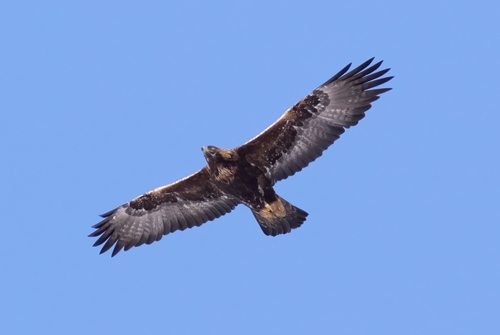
Photo Credit: SSGEP
Results are in for the 4th year of the Raptor Transect Survey Project, administered by the Game & Wildlife Conservation Trust (GWCT) for Scotland’s Regional Moorland Groups. Carried out from April to July each year, independent surveyors record the presence of raptors along 10km routes in different areas of moorland across Scotland. These moorland areas are predominantly comprising of managed heather habitat, but also incorporate some rewilding or forestry initiatives.
This year, a total of 15 transects have been monitored across four moorland areas in Southern Scotland, Tayside, Angus Glens and the Grampians, with surveys taking place once a month. The aim of this work is to build a simple index of conservation status over time for key raptor species, with the goal of enabling the GWCT’s biometrics team to detect long-term trends and raptor conservation status indices in these areas. The work has been strongly supported by Scotland’s Regional Moorland Groups and Scottish Land & Estates.
Background
The duration of each transect survey is recorded so that alongside individual species sightings, a measure of effort is logged. The monthly transect surveys are recorded using a mobile app, which enables analysts to see the time-stamp, location, species and additional notes for each record entered by the surveyor in a consistent format as soon as the monthly survey is complete and the information is uploaded. This close to ‘real-time’ update provides a wealth of prompt and valuable data.
Initial results from the 2024 survey
The project is in its early stages but we can compare this year’s numbers to those that were collected previously. Preliminary review shows that there were 523 individual raptor records submitted by the surveyors from 15 transects, compared to 484 records on 16 transects in 2023.
This year there was an increase in Golden Eagle records, from 26 to 59 - more than double the number recorded in 2023. This was most obvious on the Grampian and Angus Glens transects, accounting for just over half of the total Golden Eagle records this year. Red Kite records also increased from 63 to 86, particularly in the Angus Glens and Tayside areas. Hen Harrier records increased from 4 to 12, similar to those for Peregrines. Marsh Harriers were recorded for the 4th year in succession on one transect.
Buzzards remain the most commonly recorded raptor, comprising 35% of the total counted, consistent with 2023. Kestrel records were also very similar to last year at just under 17% of the total. Merlin records took a dip in 2024 after two years (2022, 2023) with similar records, though it must be borne in mind that the 10km transect approach is not ideal for detecting the presence of this particular species. Barn Owls, Tawny Owls, Ospreys, Sparrowhawks, and Goshawks were also recorded.
Ross Macleod, Head of Policy at GWCT in Scotland, commented: “The enthusiasm and dedication of the surveyors is such an important ingredient in making this project a success. Equally, we are very grateful to the keepers, land managers and owners on farms and estates for their co-operation with the surveyors and their continuing support of this initiative.
“It is increasingly giving us a better picture of raptor numbers on different areas of heather habitat.
“This helps illustrate the contribution of moorland and its sustainable management to Scotland’s biodiversity.”
Mark Ewart, National Engagement Manager for Scotland’s Regional Moorland Groups, said: “The regional moorland groups are delighted to have supported these surveys for a fourth year, and we are pleased to see increases in the number of recorded observations across several key species in this year’s transects.
“Land managers know that moorland management delivers decisive benefits for a range of species, including raptors. The transect survey project administered by GWCT is helping us to monitor raptor numbers, and we look forward to supporting the project in the future.”
Ross Ewing, Director of Moorland at Scottish Land & Estates, said: “It is hugely positive to see what appears to be meaningful increases in recorded observations in the 2024 survey.
“The increase for Golden Eagles is particularly striking, and rural estates have been proud to show their commitment to the conservation of this species through initiatives such as the South of Scotland Golden Eagle Project.
“Scottish Land & Estates is grateful to GWCT for their excellent administration of this project, and we look forward to supporting the work going forward.”
Issued for GWCT in Scotland by:
Dick Playfair, Playfair Walker